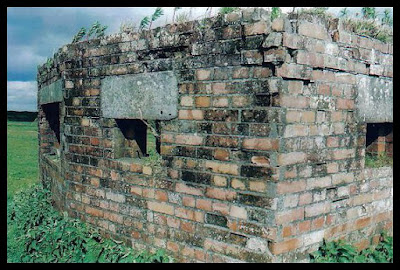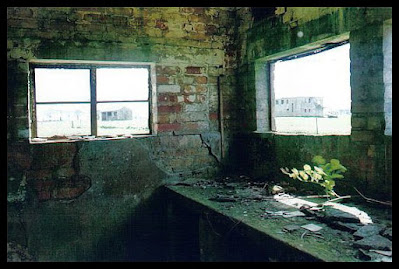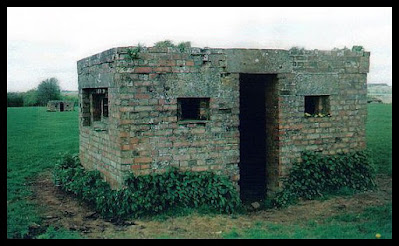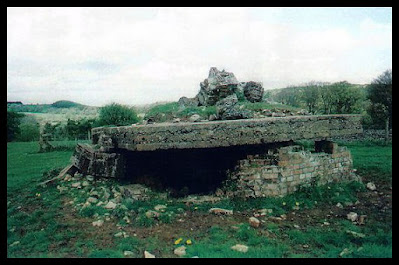Following on from the three articles of the Blackdown Hills airfields explored in 2009, I've decided to write a post about the books I've bought over the years about British WW2 defences. These aren't reviews as such but just books I've read for interest. I've also found them indispensible as reference books to check facts and jog my memory, and would be very useful to anyone wanting to know more.
Airfield Defences by Paul Francis
Published by ARP in association with AiX-ARG Archive Limited. 2010.
ISBN 978 0 9521847 0 6
As the title says, this book deals specifically with how airfields were defended, including only those buildings and installations built for that purpose. As it happens, one of the case studies is RAF Culmhead, in which I was able to correctly identify the Gun Pit and the Motley Stalk Mount (I knew it as a Lewis Gun Mount, which isn't quite accurate as it's only part of the story) and discovered other interesting info.
And an example of inside the book, showing photos and diagrams of the loopholed defensive wall and a fighter pen.
20th Century Defences in Britain edited by Bernard Lowry
Published 1996 by the Council for British Archaeology.
ISBN 1 872414 74 5
Again, this book deals specifically with defences - covering early warning systems, anti-aircraft, anti-invasion, civil defence, coastal batteries and airfields - during the period of the two world wars 1900 to 1945, and the cold war 1945 to 1992.
The example pages also show diagrams and photos. There are pages filled with text in the above books too...it just looks more interesting showing the pictures! ;)
Devon Aerodromes in Old Photographs by Keith A Saunders
Published in 1994 by Alan Sutton Publishing Limited.
ISBN 0-7509-0808-4
Found in my local second hand book shop, this is a fabulous little book, full of photographs covering their beginnings and action during World Wars I & II. As well as each chapter dealing with a different aerodrome, the final chapter is a countywide one, featuring photos of planes at shows, fairs and elsewhere in Devon, along with some of people working in the local aeroplane industry and the odd crash landing. And of course there are some photos of the 101st Airborne Division at Upottery (from Band of Brothers fame) as they were preparing to fly to Europe.
All photos with captions, the above example inside includes one of Denbury (Torbay Airport) and Dunkeswell.
I also found both of the following two in my local second-hand book shop. I thought they might be difficult to get hold of, as they were written in 1977 and 1979 respectively, but having checked I see that the first book can be obtained on ebay and several other book sites. The second book is also available on Amazon too.
Aviation Archaeology by Bruce Robertson
Published by Patrick Stephens Ltd. 1977.
ISBN 0 85059 255 0
Another great book which covers everything from aircraft, airfield buildings, crash areas & wrecks around the world, identifying finds, preservation, medals, official records and much, much more. I find it indispensable for checking out buildings I'm not quite sure of or for dating purposes.
There we go, there's some text in this page example! The Hangar drawings are a great way of identifying the different types from their shapes.
Military Archaeology by Terry Gander
Published by Patrick Stephens Ltd. 1979.
ISBN 0 85059 302 6
Another fab book filled with loads of information encompassing military architecture, defences, motor vehicles, badges & other insignia, weapons, artillery & gun posts, etc.
A couple of photos and more text on these page examples, showing a chapter about pillboxes, their types and uses.
Fields of Deception by Colin Dobinson
Published by Methuen Publishing Ltd. 2013.
ISBN 978 0 413 77632 7
This is one that I haven't read yet, or needed to use for reference, as I only bought it in the last year...and I still have a lot of new books to get through. I'm looking forward to it though, as it is an interesting subject. A technical and historically accurate book - described by the chap who recommended it to me as 'very nerdy' - as opposed to one I read some years ago about the prestigitator Jasper Maskelyne called The War Magician, which was very entertaining but unfortunately also discovered to have been largely invented.
Very few pictures in this one but there are the odd few photos and some diagrams, as seen above.
___________________
Although not books, I was also going to recommend the WWII airfield maps I bought from the RAF Museum. Having said that, I recently checked with them and unfortunately they no longer hold records that far back. I had a reccee online and discovered that the National Archives have some, although I couldn't discover how to get hold of them. Anyway, that might be the site to go to if anyone's interested in obtaining copies and here's the link to start researching there.
Just a couple of examples taken from the Upottery maps, below...
...and three newspaper cuttings from my local paper showing a visit in 2008 of two of the American 101st Airborne Division 'Band of Brothers' who were stationed at Upottery (aka Smeatharpe) before flying to Normandy in 1944.
And to finish off, a little anecdote about Exeter Airport (which was RAF Exeter during WW2). The A30 runs past the edge of the airfield and at one section there used to be a wide gate (I'm not sure it's still there as I haven't noticed it in recent years). On the gate was a notice to say that it's the emergency exit for the airport and everytime I saw it I always conjured up visions of an aeroplane gate-crashing through onto the road! I don't know if that's what was meant, but it always made me smile whenever I saw it.
I hope you found those useful. They're by no means the only books available about the subject but they're the ones that I came across either through recommendations on websites I belonged to or accidentally when browsing my local second-hand bookshop. Happy reading! :)































































































